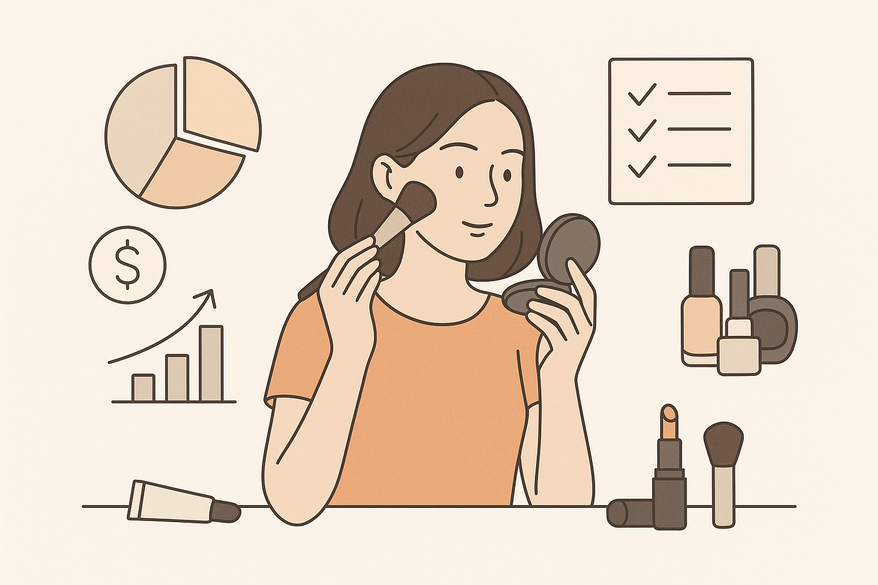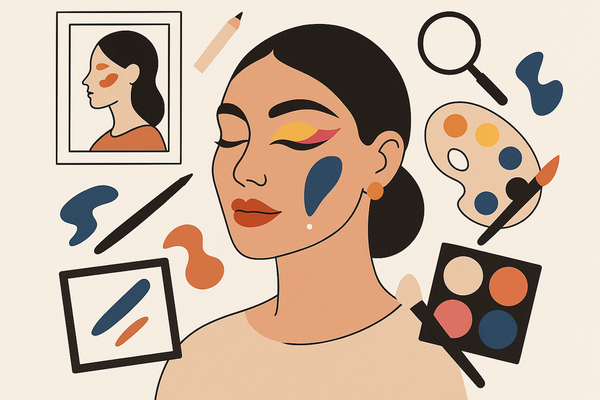Makeup Cost Breakdown: Your Complete Guide to Smarter Beauty Spending
Discover how a detailed makeup cost breakdown can help you budget better, avoid overspending, and invest wisely in high-value beauty items.

Estimated reading time: 8 minutes
Key Takeaways
- Clarity on Costs – A detailed makeup cost breakdown pinpoints where every dollar goes, from products to packaging.
- Budget Control – Tracking tools, ingredient expenses, and labor overhead helps curb impulse purchases.
- Smart Shopping – Timing your buys around sales cycles and loyalty programs maximizes value.
- Value Assessment – Per-unit cost calculations and user reviews guide you to high-impact, multi-use products.
Table of Contents
- Section I: What Is a Makeup Cost Breakdown?
- Section II: Research & Analysis of Makeup Expenses
- Section III: Budgeting Strategies for Makeup Expenses
- Section IV: Investing Smartly in Makeup Products
- Section V: Practical Tips & Step-by-Step Guide to Makeup Cost Breakdown
- Conclusion
Section I: What Is a Makeup Cost Breakdown?
Keyword: makeup cost breakdown
Definition
A makeup cost breakdown dissects total expenses into discrete categories, enabling consumers to see exactly where their money is going.
Core Components of a Makeup Cost Breakdown
- Makeup Products – Foundations, eyeshadows, lipsticks, mascaras, highlighters, and blushes. These items often represent the largest share of personal beauty spending.
- Tools – Brushes, beauty sponges, applicators, brush cleaners, and makeup removers. Quality tools can improve application but add to upfront costs.
- Accessories – Makeup organizers, travel bags, mirrors, and brush holders. Organizers keep products visible and reduce waste.
- Packaging & Raw Materials – Packaging accounts for roughly 25–50% of a cosmetic’s cost; raw ingredients (pigments, preservatives, oils) make up a significant portion of production expense (see Cosmetic Industry Economics, makeup product cost overview).
- Labor & Manufacturing Overhead – Production labor, quality control, facility costs, and management typically claim 15–25% of a product’s retail price (Cosmetic Industry Economics, makeup product cost overview).
Why Break Down Costs?
- Prioritize Spending – Knowing each cost piece lets you focus on high-impact items (e.g., investing in a versatile palette over a single shimmer shade).
- Avoid Low-Value Purchases – Spot trends in underused products and curb impulse buys.
- Plan for Replacements – Track when tools and products need refreshing to prevent gaps in your routine.
Section II: Research & Analysis of Makeup Expenses
Keyword: makeup cost breakdown
Key Cost Drivers
- Brand Tier – Luxury brands (Chanel, Dior) can cost 3–4× more than drugstore labels (Maybelline, NYX). Premium pricing often reflects marketing, packaging, and perceived prestige.
- Product Type – Specialty and high-performance items (long-wear foundations, waterproof mascaras) carry premium price tags due to advanced formulas and research costs (makeup artist pricing guide).
- Frequency of Use – Items used daily (foundation, mascara) require more frequent replacement, driving up recurring expenses. Products like setting spray may last longer but still need budgeted refills.
Methods to Track & Analyze Expenses
- Spreadsheets
– Create columns: Item name, brand, purchase date, price, replacement frequency, category.
– Use color coding to flag essentials vs. splurges.
– Update monthly to spot overspending trends. - Budgeting Apps
– Mint, YNAB (You Need a Budget), or beauty-specific trackers categorize expenses automatically.
– Set alerts for price drops or upcoming replacement dates.
– Ensure app privacy settings protect purchase data. - Online Resources
– Subscribe to beauty budgeting blogs and forums (e.g., r/MakeupRehab on Reddit).
– Access peer reviews and price comparisons.
– Leverage YouTube tutorials and screenshots of product empties to observe real-world usage rates.
– For top affordable product picks, check our drugstore foundation guide.
Consistent review of tracked data refines future purchasing decisions. You’ll spot which products last longer than claimed, which tools you rarely use, and which categories consume most of your budget. This ongoing feedback loop helps you optimize your makeup cost breakdown over time.
Section III: Budgeting Strategies for Makeup Expenses
Keyword: makeup cost breakdown
1. Set Realistic Beauty Budgets
- Review Past 6–12 Months – Tally previous purchases to calculate average monthly and annual makeup outlay.
- Fixed Percentage Method – Allocate 2–5% of your total personal budget to cosmetics. Adjust by income and lifestyle.
2. Maximize Budget Impact
- Prioritize Quality
– Invest in multi-use, long-lasting products (cream blushes that double as lipstick).
– Choose well-reviewed staples (foundation or concealer) from trusted sources. - Leverage Loyalty Programs
– Sign up for Sephora Beauty Insider, Ulta Ultamate Rewards for tiered discounts and free samples.
– Join brand waiting lists to receive sampler kits before major launches. - Employ Multi-Use Products
– Tinted moisturizers with SPF, lip-and-cheek tints, eyeshadow palettes with diverse shades.
– Reduce the number of single-use items in your routine.
Section IV: Investing Smartly in Makeup Products
Keyword: makeup cost breakdown
Evaluate Cost vs. Value
- Read & Compare User Reviews
– Check Sephora, Ulta, Beautypedia for pros, cons, and performance feedback.
– Look for before-and-after images to assess payoff. - Calculate Per-Unit Cost
– Price ÷ grams or milliliters to compare products objectively (e.g., $30/15g vs. $20/10g).
– Factor in formula longevity—some formulas dry out faster than others.
– Explore luxury makeup dupes to save money.
Purchase Timing Strategies
- Retailer Sales Cycles
– Sephora’s VIB sale, Ulta’s 21 Days of Beauty, Amazon Prime Day.
– Set calendar reminders one month before known sale periods. - End-of-Season Clearance & Holiday Bundles
– Shop post-holiday markdowns (Dec–Jan) for limited-edition sets.
– Black Friday and Friends & Family events often yield 20–30% off.
Budget Allocation Strategy
- Essentials (Daily Staples) – Assign 70–80% of your makeup budget to must-have items: foundation, concealer, mascara.
- Luxury Splurges – Allocate 20–30% to trend-driven or special-occasion purchases: high-end palettes, limited-edition glosses.
Section V: Practical Tips & Step-by-Step Guide to Makeup Cost Breakdown
Keyword: makeup cost breakdown
Actionable Money-Saving Tips
- Shop Major Sales
– Black Friday, Cyber Monday, brand anniversaries.
– Sign up for email alerts from favorite retailers. - Use Browser Extensions
– Honey and Rakuten auto-apply coupons and offer cash-back on beauty purchases.
– Check extension privacy policies to safeguard login data.
– Discover strategies in our couponing strategies guide. - Sample & Decant Programs
– Purchase mini or trial sizes to test before full-size commitment.
– Use decant services to split high-end fragrances and serums.
Step-by-Step Guide for Personalized Makeup Cost Breakdown
- List Every Makeup Product, Tool & Accessory
– Use your vanity shelf or bag as a checklist. - Record Purchase Price & Replacement Frequency
– Estimate how often you repurchase mascara (every 3–4 months) or eyeshadow pans (12–18 months). - Categorize Items as “Essential” or “Luxury”
– Essentials are daily-use staples; luxury items are occasional or trend-driven. - Calculate Monthly & Annual Cost per Item
– Formula: (Price) ÷ (Replacement Interval in months) = Monthly Cost. - Sum Totals by Category
– Compare category totals against your makeup budget cap. - Identify Areas to Cut or Reallocate
– Spot underused products or overspending categories and adjust next cycle.
Blank Template Example
| Category | Item | Price | Replace Every | Monthly Cost | Type | Notes |
|---|---|---|---|---|---|---|
| Foundation | $ | $ | Essential | |||
| Lipstick | $ | $ | Luxury | |||
| Eye Brush | $ | $ | Essential | |||
| Palette | $ | $ | Luxury |
Conclusion
A detailed makeup cost breakdown empowers you to budget effectively, avoid overspending, and invest in high-value items. By dissecting your beauty expenses into products, tools, accessories, packaging, and labor costs, you gain clarity on where your money goes. Applying research-driven insights—tracking spending, setting realistic budgets, timing purchases, and optimizing for per-unit value—ensures you spend smarter, not more. Start drafting your own makeup cost breakdown today.
For extra assistance, Makeup Check AI offers AI-driven makeup analysis and budgeting tools in one convenient app.
Share your results or budget tips in the comments below!
FAQ
How often should I review my makeup cost breakdown?
Review your makeup expenses every 3–6 months to catch new spending patterns and adjust your budget accordingly.
What is the simplest way to calculate per-unit cost?
Divide the product’s price by its weight or volume (e.g., $30 ÷ 15g) to compare costs across brands and sizes.
Can budgeting apps really track beauty expenses?
Yes. Apps like Mint or YNAB let you categorize cosmetics purchases and set alerts for upcoming replacements or sales.




